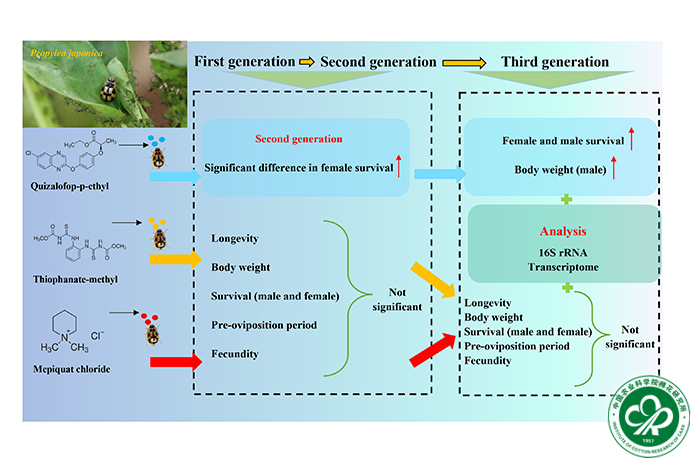- Location : Home» Newsroom
Risk assessment of predatory lady beetle Propylea japonica’smulti-generational exposure to three non-insecticidal agrochemicals
Recently, Prof. Jinjie Cui groupsystematically evaluatedthe multi-generationalexposure risk ofladybirdPropylea japonica to three non-insecticidal agrochemicals. It was found for the first time that herbicide quizalofop-p-ethyl (QpE) can improve the survival rate of this ladybird, whereas fungicide thiophanate-methyl (TM), and plant growth regulatormepiquat chloride (MC) have no significant effect on the growth and development of P. japonica. This study providesnew valuable resources which will benefit for rational application of agrochemicals in cotton fields. The resultshave been published in Science of the Total Environment,a well-known journal of entomology science (Q1, ranking20/334in journals of Environmental Sciences).
In fact, the ecological safety of insecticides has been paid much attention, whilenon-insecticidal agrochemicals have always been neglected,despite numerous reports showing that these agrochemicalscan also have negative effects on humans, mice, zebrafish, parasitic wasps, etc. P. japonica,one dominant predatory natural enemy distributing in majority of crop fields, mainly feeds on aphids and lepidoptera larvae in the cotton field with high biocontrol value. The plant growth regulatormepiquat chloride (MC), fungicide thiophanate-methyl (TM),herbicide quizalofop-p-ethyl (QpE),have been widely usedin cotton fields for decades, and their application period coincides with the occurrence period of P. japonicain cotton fields. However, the potential impact and whether thesenon-insecticidal agrochemicalswere safety to this ladybird has not been fully studied.
In this study, Prof. Cui group systematicallyevaluated multiple effects of these 3 non-insecticidal agrochemicals on three generations of P. japonicaincludingdevelopment, reproduction, enterobacteria, and transcriptomicresponse. The results showed that the multi-generation stress of MC and TM had no significant effects on the biological parameters, gene transcription expression and symbiotic bacterial community structure dynamics of P. japonica, while the survival rate and body weight of P. japonicaexposure to QpEincreased significantly. The results of multi-omics analysis showed that the decrease of detoxification metabolism caused by the down-regulation of detoxification gene expression may be compensated by increasing the abundance of symbiotic bacteria related to detoxification metabolism in P. japonica, which eventuallyimprovedthe fitness of the ladybird under multi-generation stress of QpE. Overall, this study provides a basis for the scientific application of non-insecticidal agrochemicalsin cotton fields, with an important guiding significance for promoting the stable yield of cotton, and also broadens the cognition of non-insecticidal pesticides.
The research was supported by the National Key Research and Development Program (2022YFD1400300) and Science and Technology Innovation Project of the Chinese Academy of Agricultural Sciences. Guofeng Chang, Hui Xue, and Associate Prof.Jichao Ji are the first authors of this article, and ProfJinjie Cui is the corresponding author. Link to the paper viaDOI: 10.1016/j.scitotenv.2023.163931.
